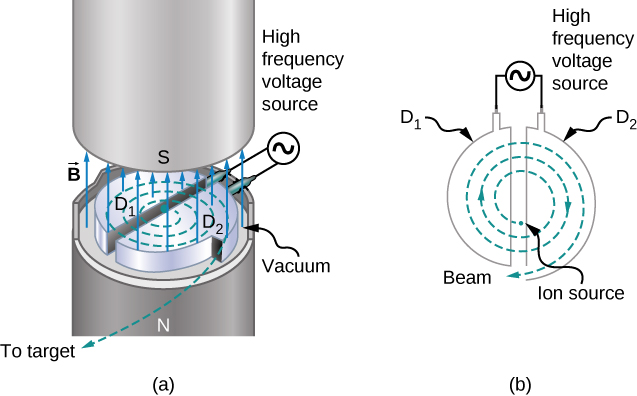| << Chapter < Page | Chapter >> Page > |
The cyclotron was developed by E.O. Lawrence to accelerate charged particles (usually protons, deuterons, or alpha-particles) to large kinetic energies. These particles are then used for nuclear-collision experiments to produce radioactive isotopes. A cyclotron is illustrated in [link] . The particles move between two flat, semi-cylindrical metallic containers D1 and D2, called dees . The dees are enclosed in a larger metal container, and the apparatus is placed between the poles of an electromagnet that provides a uniform magnetic field. Air is removed from the large container so that the particles neither lose energy nor are deflected because of collisions with air molecules. The dees are connected to a high-frequency voltage source that provides an alternating electric field in the small region between them. Because the dees are made of metal, their interiors are shielded from the electric field.

Suppose a positively charged particle is injected into the gap between the dees when D2 is at a positive potential relative to D1. The particle is then accelerated across the gap and enters D1 after gaining kinetic energy qV , where V is the average potential difference the particle experiences between the dees. When the particle is inside D1, only the uniform magnetic field of the electromagnet acts on it, so the particle moves in a circle of radius
with a period of
The period of the alternating voltage course is set at T , so while the particle is inside D1, moving along its semicircular orbit in a time T /2, the polarity of the dees is reversed. When the particle reenters the gap, D1 is positive with respect to D2, and the particle is again accelerated across the gap, thereby gaining a kinetic energy qV . The particle then enters D2, circulates in a slightly larger circle, and emerges from D2 after spending a time T /2 in this dee. This process repeats until the orbit of the particle reaches the boundary of the dees. At that point, the particle (actually, a beam of particles) is extracted from the cyclotron and used for some experimental purpose.
The operation of the cyclotron depends on the fact that, in a uniform magnetic field, a particle’s orbital period is independent of its radius and its kinetic energy. Consequently, the period of the alternating voltage source need only be set at the one value given by [link] . With that setting, the electric field accelerates particles every time they are between the dees.
If the maximum orbital radius in the cyclotron is R , then from [link] , the maximum speed of a circulating particle of mass m and charge q is
Thus, its kinetic energy when ejected from the cyclotron is
The maximum kinetic energy attainable with this type of cyclotron is approximately 30 MeV. Above this energy, relativistic effects become important, which causes the orbital period to increase with the radius. Up to energies of several hundred MeV, the relativistic effects can be compensated for by making the magnetic field gradually increase with the radius of the orbit. However, for higher energies, much more elaborate methods must be used to accelerate particles.

Notification Switch
Would you like to follow the 'University physics volume 2' conversation and receive update notifications?